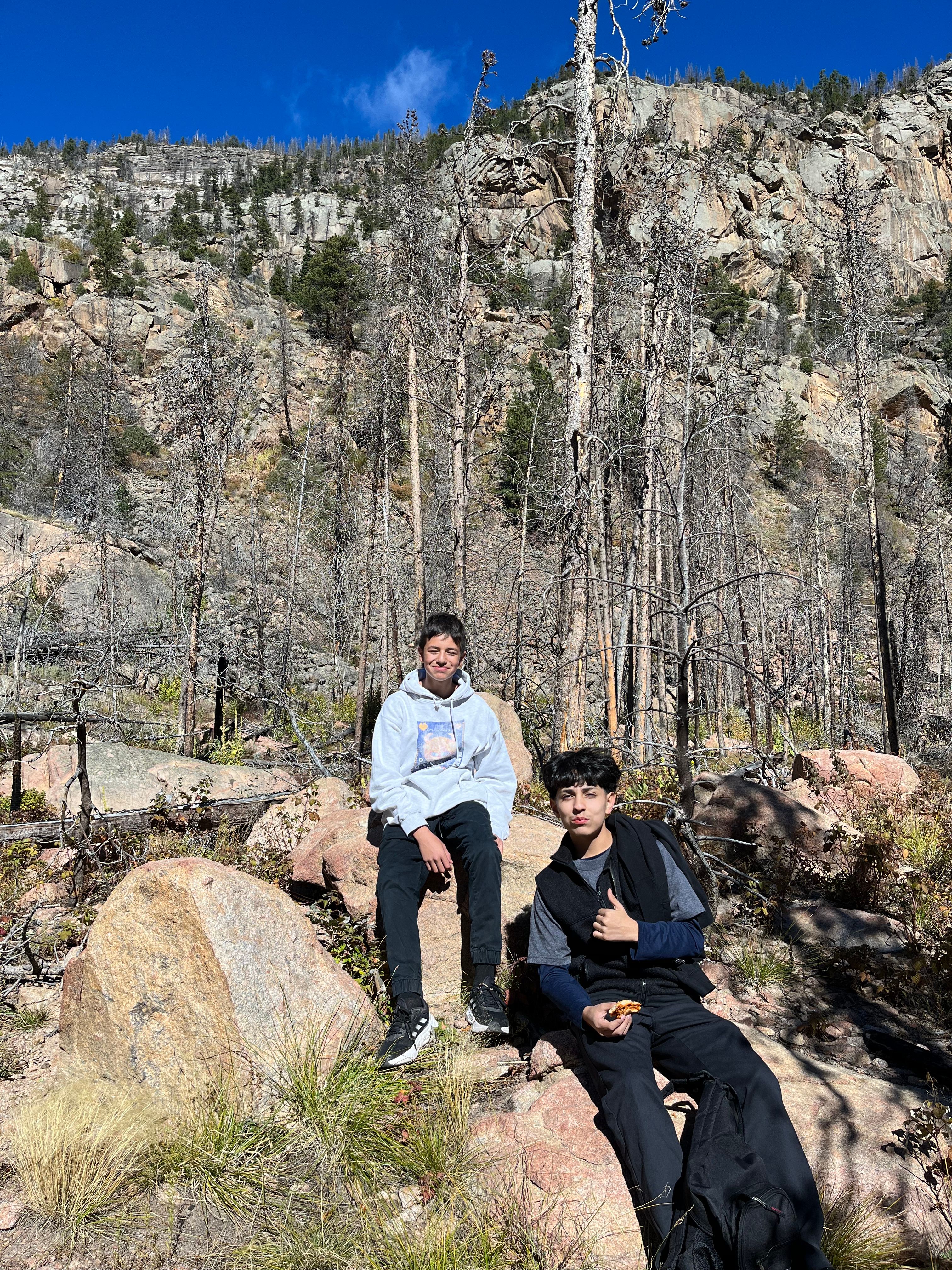A day in Rocky Mountain National Park helps students see forest recovery in real-time
Eighth graders from Thornton dive deep into CIRES' Future of Forests curriculum
On a moody cloudy day, 75 eighth graders exited two large red charter buses at the wildfire-scarred Fern Lake Trailhead in Rocky Mountain National Park. The 8th graders were visiting from STEM Launch, K-8 public school in Thornton. They made it just in time for the start of fall: The jagged snow-dusted peaks were obscured by dark clouds, and stands of golden aspens lined the hillsides.
"It’s kinda scary, the trees are black, I feel like I’m in a horror movie," said Naelynn Mann.
She and her classmates were on a science field trip to study how forests recover after wildfires. For two weeks in September, they dove deep into CIRES Education & Outreach’s Future of Forests (FoF) curriculum. Funding from CU Boulder’s Office of Outreach and Engagement meant the Thornton school could take their learning outside to one of Colorado’s national parks.
CIRES Education & Outreach’s Jon Griffith developed the curriculum, and he coordinated funding for the excursion.
“I think a lot of times students think of science as a set of established facts that can be disconnected from their daily lives,” said Griffith. “In this project, I was excited to support students in developing and applying new understandings of the dynamic nature of post-fire landscape recovery, both through innovative classroom curricula, and observing a fire-prone ecosystem in their ‘backyard’, Rocky Mountain National Park.”
Griffith developed the Future of Forests curriculum after learning that forests across the Rocky Mountains are struggling to recover following wildfires due to climate change. In a future that is projected to be warmer and drier, we can expect to see some landscapes that were forested before a wildfire transition to shrubland or grassland ecosystems after a wildfire.
The NASA-supported curriculum explores online interactives, data, and citizen science methods used to construct explanatory models for the driving question, “How do landscapes recover after a wildfire?”
Walking through the burn scars of the 2012 Fern Lake Fire and the 2020 East Troublesome Fire is a perfect way to see the Future of Forests curriculum in real-time, allowing students to observe and compare landscape recovery from fires that occurred at different times and at different scales. The more recent East Troublesome Fire was the second largest in Colorado history, burning 193,812 acres, according to the U.S. Forest Service.
Jordan Denning is the 8th-grade science teacher at STEM Launch; he worked with Griffith to organize the trip to the park to put the Future of Forests curriculum into practice. He was excited about teaching his students about wildfire and forests coupled with the opportunity to get outside. For many, the day offered a first-time hiking experience.
“I noticed they really connected with fire,” said Denning. “And it was interesting to see how their ideas changed over two weeks.”
They hiked along the mostly flat trail alongside the Big Thompson River, surrounded by charred trees and stumps while making observations. Some touched the burned tree trunks, rubbing charcoal and ash between their fingertips and on their faces. Others noticed new growth: knee-high green foliage.
On studying wildfires: "We learned about how we can detect them, like (with) satellites. We learned about controlled fires, areas they burn that need to be burned to help the fire," Dylan Rodriguez.
Naelynn Mann (left) and Dylan Rodriguez (right) pose among the burnt trees.

"We learned after forest fire, they (forests) are not healing. because of climate change. When trees fell they would drop seeds so they would re-grow. I didn’t know that was a thing, didn’t know they had seeds inside of them," Martin Mejia.
Marcos Velasco (left) and Martin Mejia (right) pose ontop a boulder while taking a lunch break.
On being outside, "It’s nice to know what I’m actually learning about. A lot of things impact wildfire, different things, like how dry the soil is, the air, and climate change," April Reyes.
April Reyes, center, poses with friends and social studies teacher, Nathan English, while learning about forest recovery in Rocky Mountain National Park.
After a full morning of hiking, and lunch alongside the river in the dim autumn sun, Denning noticed how students took in their surroundings. A lot of dead charred trees were surrounded by healthy green shrubs and trees.
“They are all saying since they are seeing a lot of new growth, they think it’s recovering well,” Denning said. “In some places, the new growth is already head-high.”
This recovery, likely from the 2012 Fern Lake Fire, may indicate that conditions were cooler and wetter in the years following the fire.
At the trailhead, students lined up to board the buses back to Denver. While their field trip was over, their lessons on fire would continue. Denning next had students looking into solutions for managing wildfires; they presented ideas to a panel of experts, including Jon Griffith.
For Denning, facilitating the experience outdoors was exciting, with benefits beyond what his students learn in the classroom.
“Seeing them get so excited about something related to school is awesome,” said Denning. “I was talking to one of the kids and they said they’d never been hiking before. And to have your first hike be in Rocky Mountain National Park and on this trail is just so beautiful.”